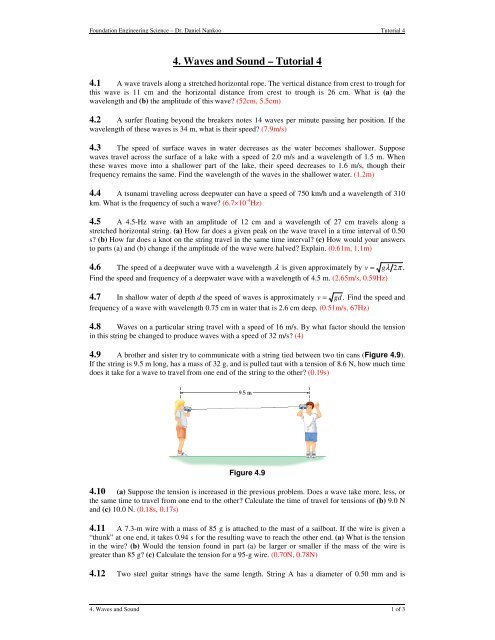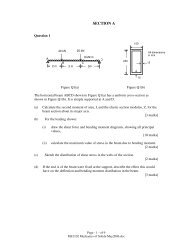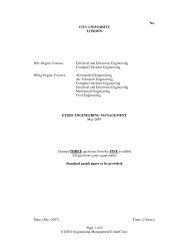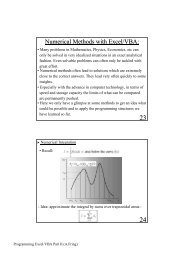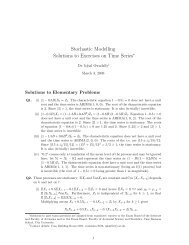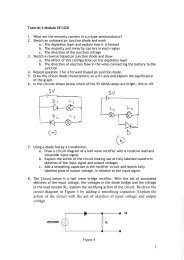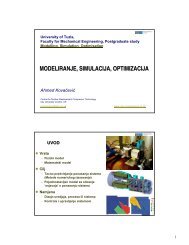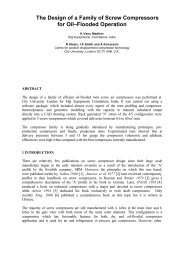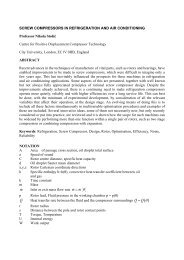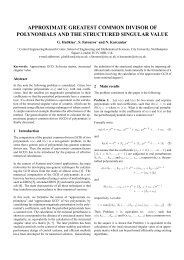4. Waves and Sound – Tutorial 4 - Staff.city.ac.uk
4. Waves and Sound – Tutorial 4 - Staff.city.ac.uk
4. Waves and Sound – Tutorial 4 - Staff.city.ac.uk
You also want an ePaper? Increase the reach of your titles
YUMPU automatically turns print PDFs into web optimized ePapers that Google loves.
Foundation Engineering Science <strong>–</strong> Dr. Daniel Nankoo <strong>Tutorial</strong> 4<br />
<strong>4.</strong> <strong>Waves</strong> <strong>and</strong> <strong>Sound</strong> <strong>–</strong> <strong>Tutorial</strong> 4<br />
<strong>4.</strong>1 A wave travels along a stretched horizontal rope. The vertical distance from crest to trough for<br />
this wave is 11 cm <strong>and</strong> the horizontal distance from crest to trough is 26 cm. What is (a) the<br />
wavelength <strong>and</strong> (b) the amplitude of this wave? (52cm, 5.5cm)<br />
<strong>4.</strong>2 A surfer floating beyond the breakers notes 14 waves per minute passing her position. If the<br />
wavelength of these waves is 34 m, what is their speed? (7.9m/s)<br />
<strong>4.</strong>3 The speed of surf<strong>ac</strong>e waves in water decreases as the water becomes shallower. Suppose<br />
waves travel <strong>ac</strong>ross the surf<strong>ac</strong>e of a lake with a speed of 2.0 m/s <strong>and</strong> a wavelength of 1.5 m. When<br />
these waves move into a shallower part of the lake, their speed decreases to 1.6 m/s, though their<br />
frequency remains the same. Find the wavelength of the waves in the shallower water. (1.2m)<br />
<strong>4.</strong>4 A tsunami traveling <strong>ac</strong>ross deepwater can have a speed of 750 km/h <strong>and</strong> a wavelength of 310<br />
km. What is the frequency of such a wave? (6.7×10 -4 Hz)<br />
<strong>4.</strong>5 A <strong>4.</strong>5-Hz wave with an amplitude of 12 cm <strong>and</strong> a wavelength of 27 cm travels along a<br />
stretched horizontal string. (a) How far does a given peak on the wave travel in a time interval of 0.50<br />
s? (b) How far does a knot on the string travel in the same time interval? (c) How would your answers<br />
to parts (a) <strong>and</strong> (b) change if the amplitude of the wave were halved? Explain. (0.61m, 1.1m)<br />
<strong>4.</strong>6 The speed of a deepwater wave with a wavelength λ is given approximately by v = gλ 2 π .<br />
Find the speed <strong>and</strong> frequency of a deepwater wave with a wavelength of <strong>4.</strong>5 m. (2.65m/s, 0.59Hz)<br />
<strong>4.</strong>7 In shallow water of depth d the speed of waves is approximately v = gd . Find the speed <strong>and</strong><br />
frequency of a wave with wavelength 0.75 cm in water that is 2.6 cm deep. (0.51m/s, 67Hz)<br />
<strong>4.</strong>8 <strong>Waves</strong> on a particular string travel with a speed of 16 m/s. By what f<strong>ac</strong>tor should the tension<br />
in this string be changed to produce waves with a speed of 32 m/s? (4)<br />
<strong>4.</strong>9 A brother <strong>and</strong> sister try to communicate with a string tied between two tin cans (Figure <strong>4.</strong>9).<br />
If the string is 9.5 m long, has a mass of 32 g, <strong>and</strong> is pulled taut with a tension of 8.6 N, how much time<br />
does it take for a wave to travel from one end of the string to the other? (0.19s)<br />
Figure <strong>4.</strong>9<br />
<strong>4.</strong>10 (a) Suppose the tension is increased in the previous problem. Does a wave take more, less, or<br />
the same time to travel from one end to the other? Calculate the time of travel for tensions of (b) 9.0 N<br />
<strong>and</strong> (c) 10.0 N. (0.18s, 0.17s)<br />
<strong>4.</strong>11 A 7.3-m wire with a mass of 85 g is att<strong>ac</strong>hed to the mast of a sailboat. If the wire is given a<br />
“thunk” at one end, it takes 0.94 s for the resulting wave to re<strong>ac</strong>h the other end. (a) What is the tension<br />
in the wire? (b) Would the tension found in part (a) be larger or smaller if the mass of the wire is<br />
greater than 85 g? (c) Calculate the tension for a 95-g wire. (0.70N, 0.78N)<br />
<strong>4.</strong>12 Two steel guitar strings have the same length. String A has a diameter of 0.50 mm <strong>and</strong> is<br />
<strong>4.</strong> <strong>Waves</strong> <strong>and</strong> <strong>Sound</strong> 1 of 3
Foundation Engineering Science <strong>–</strong> Dr. Daniel Nankoo <strong>Tutorial</strong> 4<br />
under 410.0 N of tension. String B has a diameter of 1.0 mm <strong>and</strong> is under a tension of 820.0 N. Find<br />
the ratio of the wave speeds, vA vB , in these two strings. (1.4)<br />
<strong>4.</strong>13 Dolphins of the open ocean are classified as Type II Odontocetes (toothed whales). These<br />
animals use ultrasonic “clicks” with a frequency of about 55 kHz to navigate <strong>and</strong> find prey. (a)<br />
Suppose a dolphin sends out a series of clicks that are reflected b<strong>ac</strong>k from the bottom of the ocean 75<br />
m below. How much time elapses before the dolphin hears the echoes of the clicks? (The speed of<br />
sound in seawater is approximately 1530 m/s.) (b) What is the wavelength of 55 kHz sound in the<br />
ocean? (0.098s, 28mm)<br />
<strong>4.</strong>14 A sound wave in air has a frequency of 425 Hz. (a) What is its wavelength? (b) If the<br />
frequency of the sound is increased, does its wavelength increase, decrease, or stay the same? Explain.<br />
(c) Calculate the wavelength for a sound wave with a frequency of 475 Hz. (0.807m, 0.722m)<br />
<strong>4.</strong>15 When you drop a rock into a well, you hear the splash 1.2 seconds later. (a) How deep is the<br />
well? (b) If the depth of the well were doubled, would the time required to hear the splash be greater<br />
than, less than, or equal to 3.0 seconds? Explain. (11m)<br />
<strong>4.</strong>16 A rock is thrown downward into a well that is 8.80 m deep. If the splash is heard 1.20 seconds<br />
later, what was the initial speed of the rock? (-1.7m/s)<br />
<strong>4.</strong>17 The intensity level in a truck is 92 dB. What is the intensity of this sound? (1.6mW/m 2 )<br />
<strong>4.</strong>18 The distance to a point source is decreased by a f<strong>ac</strong>tor of three. (a) By what multiplicative<br />
f<strong>ac</strong>tor does the intensity increase? (b) By what additive amount does the intensity level increase? (1/9, -<br />
9.54)<br />
2<br />
<strong>4.</strong>19 <strong>Sound</strong> 1 has an intensity of 38. 0 W m . <strong>Sound</strong> 2 has an intensity level that is 2.5 dB greater<br />
than the intensity level of sound 1. What is the intensity of sound 2? (67.6W/m 2 )<br />
<strong>4.</strong>20 Residents of Hawaii are warned of the appro<strong>ac</strong>h of a tsunami by sirens mounted on the top of<br />
towers. Suppose a siren produces a sound that has an intensity level of 120 dB at a distance of 2.0 m.<br />
Treating the siren as a point source of sound, <strong>and</strong> ignoring reflections <strong>and</strong> absorption, find the intensity<br />
level heard by an observer at a distance of (a) 12 m <strong>and</strong> (b) 21 m from the siren. (c) How far away can<br />
the siren be heard? (104dB, 99.6dB, 2.0×10 6 m)<br />
<strong>4.</strong>21 In a pig-calling contest, a caller produces a sound with an intensity level of 110 dB. How<br />
many such callers would be required to re<strong>ac</strong>h the pain level of 120 dB? (10)<br />
<strong>4.</strong>22 Twenty violins playing simultaneously with the same intensity combine to give an intensity<br />
level of 82.5 dB. (a) What is the intensity level of e<strong>ac</strong>h violin? (b) If the number of violins is increased<br />
to 40, will the combined intensity level be more than, less than, or equal to 165 dB? Explain. (69.5dB)<br />
<strong>4.</strong>23 The radius of a typical human eardrum is about <strong>4.</strong>0 mm. Find the energy per second received<br />
by an eardrum when it listens to sound that is (a) at the threshold of hearing <strong>and</strong> (b) at the threshold of<br />
pain. (5×10 -17 W, 5×10 -5 W)<br />
<strong>4.</strong>24 A point source of sound that emits uniformly in all directions is located in the middle of a<br />
large, open field. The intensity at Brittany’s location directly north of the source is twice that at<br />
Phillip’s position due east of the source. What is the distance between Brittany <strong>and</strong> Phillip if Brittany is<br />
12.5 m from the source? (21.7m)<br />
<strong>4.</strong>25 A train moving with a speed of 31.8 m/s sounds a 136-Hz horn. What frequency is heard by<br />
an observer st<strong>and</strong>ing near the tr<strong>ac</strong>ks as the train appro<strong>ac</strong>hes? (150Hz)<br />
<strong>4.</strong>26 In the previous problem, suppose the stationary observer sounds a horn that is identical to the<br />
one on the train. What frequency is heard from this horn by a passenger in the train? (149Hz)<br />
<strong>4.</strong> <strong>Waves</strong> <strong>and</strong> <strong>Sound</strong> 2 of 3
Foundation Engineering Science <strong>–</strong> Dr. Daniel Nankoo <strong>Tutorial</strong> 4<br />
<strong>4.</strong>27 A particular jet engine produces a tone of 495 Hz. Suppose that one jet is at rest on the tarm<strong>ac</strong><br />
while a second identical jet flies overhead at 82.5% of the speed of sound. The pilot of e<strong>ac</strong>h jet listens<br />
to the sound produced by the engine of the other jet. (a) Which pilot hears a greater Doppler shift?<br />
Explain. (b) Calculate the frequency heard by the pilot in the moving jet. (c) Calculate the frequency<br />
heard by the pilot in the stationary jet. (903Hz, 2.83kHz)<br />
<strong>4.</strong>28 Two bicycles appro<strong>ac</strong>h one another, e<strong>ac</strong>h traveling with a speed of 8.50 m/s. (a) If cyclist A<br />
beeps a 315-Hz horn, what frequency is heard by cyclist B? (b) Which of the following would cause<br />
the greater increase in the frequency heard by cyclist B: (i) Cyclist A speeds up by 1.50 m/s, or (ii)<br />
cyclist B speeds up by 1.50 m/s? Explain. (330Hz)<br />
<strong>4.</strong>29 A train on one tr<strong>ac</strong>k moves in the same direction as a second train on the adj<strong>ac</strong>ent tr<strong>ac</strong>k. The<br />
first train, which is ahead of the second train <strong>and</strong> moves with a speed of 35.8 m/s, blows a horn whose<br />
frequency is 124 Hz. If the frequency heard on the second train is 133 Hz, what is its speed? (63.3m/s)<br />
<strong>4.</strong>30 Two cars traveling with the same speed move directly away from one another. One car sounds<br />
a horn whose frequency is 205 Hz <strong>and</strong> a person in the other car hears a frequency of 192 Hz. What is<br />
the speed of the cars? (11.2m/s)<br />
<strong>4.</strong>31 The Shinkansen, the Japanese “bullet” train, runs at high speed from Tokyo to Nagoya. Riding<br />
on the Shinkansen, you notice that the frequency of a crossing signal changes markedly as you pass the<br />
crossing. As you appro<strong>ac</strong>h the crossing, the frequency you hear is f; as you recede from the crossing the<br />
frequency you hear is 2 f 3. What is the speed of the train? (68.6m/s)<br />
<strong>4.</strong> <strong>Waves</strong> <strong>and</strong> <strong>Sound</strong> 3 of 3


